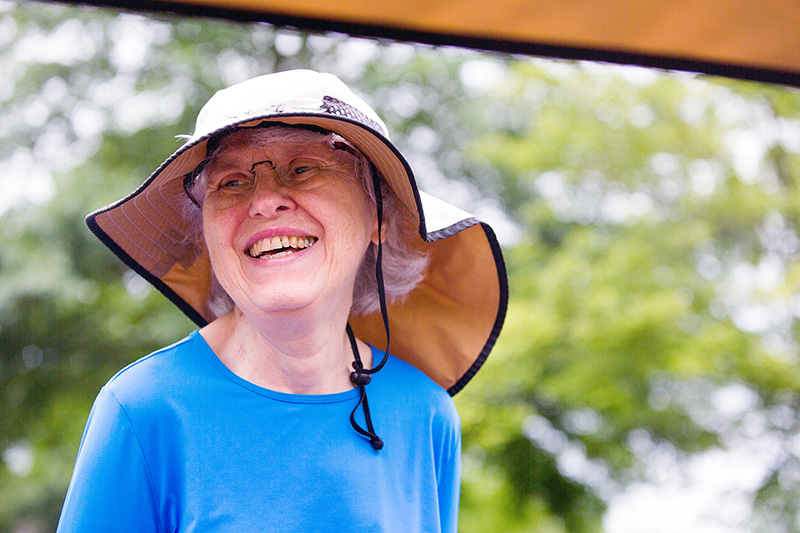August 4, 2023 —The physical and emotional benefits of being outside are undeniable, especially for older adults, and summertime offers ample hours and opportunities to soak up the sun and fun.

Seniors Are at Greater Risk
But sun and heat can pose greater health risks for seniors, particularly in these times of climate change when temperatures frequently soar above 100 degrees.
Consider these findings from the CDC and other agencies:
- Older bodies are less efficient at regulating temperatures because they don’t sweat as much as their younger counterparts.
- According to Climate Central, more than 80% of the estimated 12,000 people in the U.S. who die of heat-related causes annually are over 60.
- Most cases of skin cancer (the leading type of cancer in the U.S.) are found in people aged 65 and above, yet less than half of older adults adequately protect their skin.
- Seniors are more likely to have chronic health conditions that affect the body’s response to temperature. As such, they are more likely to take multiple medications, some of which can alter reactions to heat or sun.
Too Hot to Handle
Let’s explore some common sun- and heat-related conditions to which older bodies are particularly vulnerable. If any of the following incidents cannot be improved quickly, do not hesitate to contact emergency services, and always get medical attention in the case of life-threatening heat stroke.
- Heat syncope (dizziness) can come on suddenly in hot weather, posing a risk for fainting, falling and serious injury. This is especially troublesome for older adults with weaker muscles and brittler bones.
- Move to a cool place immediately.
- Hydrate with water, juice or a sports drink with electrolytes (Gatorade, for example).
- Avoid alcoholic or caffeinated beverages.
- Sit or lie down, elevate legs and apply a cool compress to the head and face.
- Heat cramps are spasms or tightening of the muscles, particularlyin the arms, legs or stomach.The skin may feel moist and cool, even in hot weather.
- Cease physical activity and rest in a cool place.
- Hydrate with water or a sports drink.
- Heat edema is heat-induced swelling of the feet and ankles.
- Move to a cool place and elevate the legs.
- Apply a cooling foot spray or a blast of cold water on the affected areas.
- Heat exhaustion happens when your body can no longer keep cool. Symptoms are thirst, dizziness, a lack of coordination, weakness, nausea, vomiting, headache and muscle cramps. Your skin may feel cold and clammy, and you may have a rapid pulse.
- Rest in a cool place and drink ample hydrating fluids.
- If you don’t feel better relatively quickly, seek medical attention, as heat exhaustion can develop into heat stroke.
- Heat stroke is a serious medical emergency in which body temperature rises above 104°F. Seniors are more likely to suffer from heat stroke than younger adults. Symptoms are fainting, confusion or unusual behavior, hot, dry, flushed skin without the presence of sweating, a strong and rapid or slow and weak pulse.
- Call for medical help immediately and move the affected person to a cool place.
- Until help arrives, help lower body temperature with fans, a cool bath, shower or gentle ice compresses.
- Loosen or remove clothing.
- Sunburn is the result of too much exposure to harmful ultraviolet (UV) radiation.
- Seek medical attention if a sunburn is severe, causing significant blistering, fever, nausea, headache or fatigue.
- Drink plenty of water or fluids with electrolytes.
- Apply a topical sunburn relief product with aloe or lidocaine.
- Apply cool, damp compresses to the skin.
- Take over-the-counter pain relievers (monitor intake in those with cognitive issues).
- Frequently apply moisturizer.
- Do not pick bumps or blisters to avoid risk of infection; resist peeling skin, which can damage the tender layers underneath.
Avoidance Is Everything
Despite the risks, simple precautions can keep our older loved ones safe in the sun and heat.
- The hydration equation. Dehydration is a common problem among older adults. The thirst sensation decreases as we age, and changes in water and sodium balance occur. While seniors tend to sweat less than younger people, they are still susceptible to losing vital water and electrolytes as their bodies attempt to cool down when temperatures rise.
- Drink plenty of water, juices and drinks fortified with electrolytes.
- Avoid dehydrating alcoholic or caffeinated beverages.
- Maximum coverage. Older adults were raised in a time when the dangers of ultraviolet rays were largely unknown. Back then, people slathered their skin with baby oil and stretched out on foil mats. No wonder serious sunburns ruined many a vacation! In addition to the damage seniors may have unwittingly done to their skin when they were younger, older skin is thinner and loses fat and water content more easily, allowing UV rays to penetrate more deeply.
- Regularly apply sunscreen with an SPF of at least 30, regardless of your skin type or color. No matter what the label says, no sunscreen is truly waterproof, so reapply even more often if you’re in the water or sweating a lot. UV wristbands detect solar radiation and change colors when it’s time to reapply sunscreen.
- Seek plenty of shade on sizzling summer days and be sure to bring a large umbrella if you’re planning to be in the sun for extended periods. Some sun umbrellas have UV protection built into them.
- Wear protective clothing, including hats with ear and neck flaps, sunglasses to prevent eye and vision damage (eyes can get sunburned, too!), tightly woven linen or cotton shirts and pants in light colors that reflect the sun’s heat. Some clothing has SPF protection built into the fabric.
Even when the mercury rises and the sun is blazing full strength, seniors – and everyone – can stay safe all summer long.
Discover Your Best Life
Inside and Out